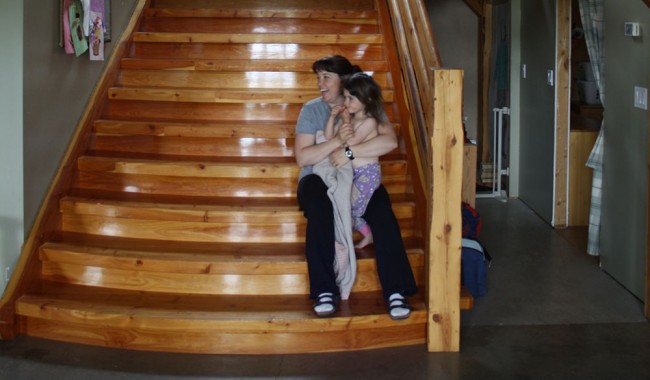
Photo Credit: Norma Kerby
The straw playhouse: Winter habitat for busy children
“So what did your children do when it was minus forty?”
I am talking to friend and author Joyce Helweg about the challenges of living in Fort St. James. Having just visited thousands of toad tadpoles in her horse pond, the conversation had lapsed into a discussion about where animals hide in cold weather. If you are a toad, winter is easy—dig down into the moist bottom of a pond below frost level and hibernate until spring. If you are a human, cold northern-interior temperatures can present interesting problems, especially for a household full of lively little people.
“You need to meet my daughter, Leslie. She lives in a straw-bale house and has a swing in her front room. Her kids are always busy.” Joyce knows my weak spot for unusual rural houses so it is off to Leslie’s farm down the road we go.
Northern housing sometimes takes on inspired adaptations to climate and location. Just what do you do with four active children when it is too cold to let them play outside? Leslie and Chad Lantz’s place is not a disappointment. You build a house that functions as both a playground and a home.
When I ask Leslie how they arrived at the design for their home, she smiles. Her childhood in the 1980s was spent in a 100-foot-long log ranch-house with an indoor swimming pool. Her parents, Joyce and Johnny, felt that their children should learn to swim. There has never been a municipal swimming pool at the Fort, and the many large lakes in the region are chilly, even in summer. The obvious rural solution: build your own indoor swimming pool so the children can be in the water, even in winter.
“They all swim like seals,” Joyce answers as she shrugs off my admiration.
Skateboards and bikes
It was the long, open floor space of Leslie’s childhood home that influenced construction plans when she and Chad built their house.
“Watch out for the skateboards and bikes!” Joyce warns me as we step into Leslie’s house. What Joyce means is to watch out for the skateboards and bikes with children on them. A post-and-beam straw-bale house needs a firm foundation, and the floor is a cement slab heated by an outdoor wood furnace.
“We were going to put in flooring, but the cement is so warm in the winter, we left it as is,” Leslie explains as she tours us around the bottom level.
With an open room plan, and an indestructible floor, Leslie’s house is ideal as a winter playground. Children can ride and skate from the front room to the kitchen, getting all the exercise they need. Regular exercise is especially important for Leslie’s middle son, who is diabetic. Living in a home where he is encouraged to be physically active, both inside and outside, allows him to be healthy and happy.
The house’s post-and-beam design has also allowed other child-friendly options, such as a full-sized swing attached to an overhead beam, along with a system of pulleys that the children use to move various objects to and from the second floor.
“They are all going to become engineers,” Joyce whispers to me.
It is the staircase that totally overwhelms me. Sweeping down like a Cinderella movie set, the broad, hand-made wooden stairway provides a magnificent entrance between the two floors. Compared to the narrow, functional steps in most houses, imagine being a child in a home with a grand staircase that rivals the Chateau Frontenac. A variety of creative projects often spill down the sides, and a mattress is used to slide between the two levels.
As Leslie’s daughter swings back and forth past me, I am called over to look at the “truth” window in the wall. Opening up a small, hinged door, Leslie points out the straw that forms the walls of her house, walls that are over 60 cm thick.
“No matter how cold it is outside, we are always warm inside,” Leslie grins. “And the house is cool in summer.” In a climate where summer temperatures can get over 25 C and winter temperatures below -40 C, the house’s thick walls provide constant insulation and a comfortable living zone year-round.
Youthful energy
Building a straw-bale house is not easy. Having decided they wanted to build a home with natural materials that would not off-gas harmful chemicals, Leslie and Chad researched different options. Aware of the very cold winters in the Fort St. James area, they chose a straw-bale design. According to Leslie, it was a good choice, but more complex than they ever imagined. Dry straw bales, fitted between the posts and beams, were knitted with binder twine onto quilts of chicken wire. Plaster was then hand-trowelled inside and outside to seal the walls against moisture and rodents. It took 400 bales to fill the walls.
“We had a lot of help from friends and family,” Leslie explains, “as well as assistance from an excellent local carpenter.” They undertook most of the work themselves, though. “Now, when the kids come inside from the snow soaking wet, who cares?” Leslie smiles as she takes us through the built-in boot room. “The floor is warm and they just leave everything to dry to be hung up later. When it is really cold, the dogs, cats and children find the warmest patches on the cement and sit there.”
Lunch is at a broad, hand-made wood table. In this house, children are included in conversations, so they all have their own opinions about why they like to live where they do. Soon, though, youthful energy wins out and they spill out the door to practise shooting bows and arrows at a target in the yard.
According to Leslie, one of their straw-bale house’s biggest benefits is the freedom it offers her children for hands-on learning. Hammers, nails and saws are welcome inside during winter. Crafts and projects abound throughout the house. Through extended family and friend get-togethers, her children know that they belong in a community of people who like to do things for themselves. This is a home where it is normal for someone to be building something.
When asked how these children will ever relate to the broader urbanized world, she just smiles again. “If you raise your children to think they can do a good job and tackle anything, they will be able to look after themselves.”
Building a straw-bale house
As an economical, environmentally friendly building material, straw is becoming increasingly popular in construction of green housing. The literature on straw-bale construction is extensive. A good overview is provided in the book, Natural Timber Frame Homes: Building with Wood, Stone, Clay, and Straw by W. Bingham and J. Pfeffer, 2007. According to Leslie and Chad, because special methods are required in construction of a straw-bale house, their best advice is to contact people who are familiar with straw-bale building methods and, if possible, visit a straw-bale house to see first-hand how they are made.





